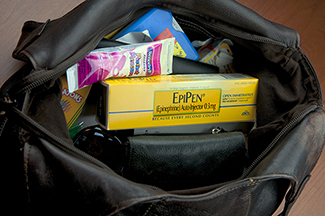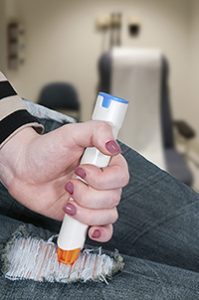
Over the years, I’ve found that patients have a lot of important questions about epinephrine. Here are some answers.
What is epinephrine?
Epinephrine, or epi, is a form of adrenaline. Adrenaline is a hormone that is naturally produced in our bodies and is released in emotional situations that cause fear or anger—commonly called the “fight or flight” response. Our bodies release adrenaline to prepare us to take action. When released, it causes a short-lived increase in heart rate, muscle strength, blood pressure and sugar metabolism.
An automatic, injectable epinephrine device is commonly called an EpiPen, which is a specific brand name. There are actually several injectable epinephrine devices available, although EpiPen and Auvi-Q are the most well known.
An auto injector of epi mimics the body’s own adrenaline, providing a dose that is equivalent to what your own body might release in the event of an accident or nightmare.
Who needs epinephrine?
Patients who have life-threatening allergies, such as a drug, food or honeybee allergy, are prescribed an automatic injectable epinephrine device. If you are allergic to a substance, your immune system overreacts to this allergen by releasing chemicals that cause allergy symptoms.
When is epinephrine needed?
When someone has an allergic reaction, also known as anaphylaxis, a serious life-threatening reaction is occurring. Symptoms of anaphylaxis are not the same for everyone or every reaction, but may include:
• Hives
• Itching
• Redness
• Tightness of the chest
• Tightness of the throat
• Swelling of the lips, tongue and/or mouth
• Difficulty breathing
Anaphylaxis can also cause chest pain, low blood pressure and dizziness.
It is hard to know when to use epi. However, current guidelines tell us that immediate epi treatment provides the best outcome. Anyone showing any anaphylactic symptoms needs to be treated with epi immediately.

Woman injecting emergency medicine into her leg
Where should epinephrine be injected?
Epinephrine typically comes as a single-dose pre-filled automatic injection device that needs to be injected into the upper thigh (the quadriceps or quad). Providing a shot of epi will temporarily increase the person’s heart rate and blood pressure and cause other symptoms to diminish until help can be sought. After performing an injection, call 911 and transport the person to the nearest emergency room.
Why is epinephrine needed?
Anaphylaxis is life threatening and can worsen rapidly. If delayed, it may be too late to reverse the reaction. Waiting to see how a reaction progresses can lead to irreversible damage or death. Don’t wait for a medical professional to say it’s OK to administer epi. It is safer to give an epi injection than to wish you did. Those with severe allergy or a history of anaphylaxis should carry injectable epi at all times.
It’s important to prepare an emergency action plan with your provider. We welcome your questions. Contact us to make an appointment.
 (541) 233-4064
(541) 233-4064 
